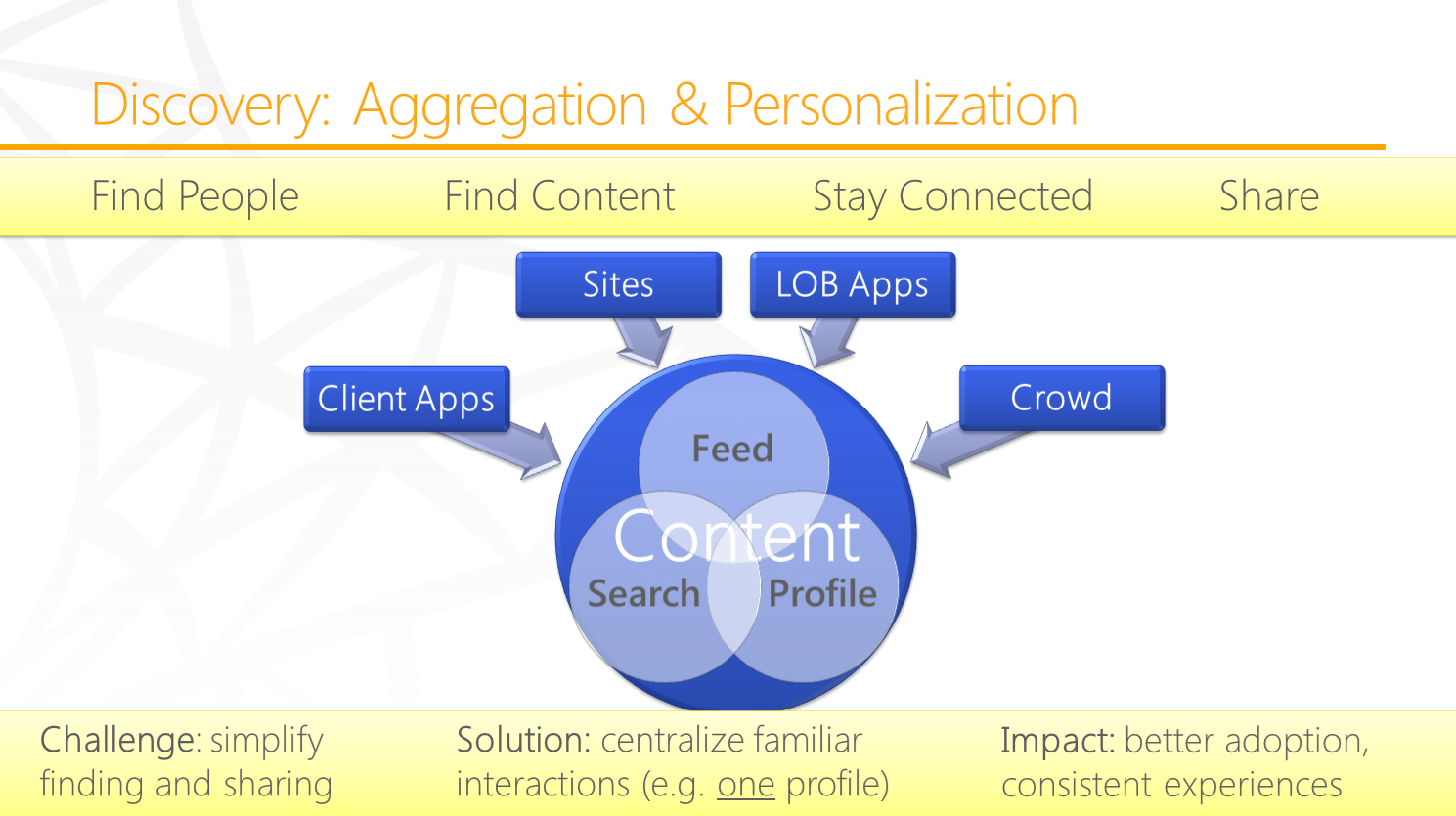Making Microsoft Social
This is a guest blog post by Chris Slemp, senior solutions manager, strategic enterprise services IT within Microsoft IT. Chris works on an internal IT team focused on improving collaboration within Microsoft, with an emphasis on creating a social enterprise. This is part 1 of a 2-part blog about the Microsoft’s internal social enterprise initiative.
I’ve been working in Microsoft IT for several years, and several other areas of Microsoft before that. Throughout my career I can count on one hand what I would call “moments of truth.” By this I mean critical moments in time, perhaps 7 seconds, in which a person encounters a product or service and chooses to engage, and from there spawns new thinking. Proctor & Gamble has effectively used this concept in the world of consumer packaged goods (CPG), and I contend it extends to the business world, too.
One such moment of truth was in September 2010 at Microsoft’s massive company meeting inside Safeco, Seattle’s downtown baseball park. The company meeting is an internal-only event, and is attended in-person by more than 20,000 employees. The keynotes, demos and entertainment are marketed and presented as only for Microsoft employees. With the large number of GenXers and Millennials in the workplace, who have come to expect to interact online or grown up communicating online, some internal information that year was shared on external social media sites (Twitter, Facebook) and then published by external media outlets.
The leaks weren’t intentional or nefarious by design. The fact of the matter is today’s employees want and expect to share their thoughts in the moment, and engage with fellow employees who aren’t sitting near them but rather sitting on the opposite side of the ballpark, in this instance. These employees had no internal social tools to share their experiences and thoughts, so they chose what they’re used to using: Twitter or Facebook.
This moment in time, and the resulting press headlines, helped crystalize the internal demand for social computing tools within Microsoft and helped validate the early work of a Microsoft IT project, somewhat pretentiously called the Next-Generation Intranet.
The Modern Intranet
Along these lines, Microsoft has a mix of employees from different generations. We know that social networking appeals to more than just Millennials. I was excited to see a survey [eMarketer, February 2011] that showed more than half of those 55-64 years old use social networks via any device at least once a month. It’s 2/3 for people 45-54 years old, and higher use for groups down to age 12. In short, we determined that the social enterprise is moving from a “nice to have” to a “must have” in our internal communications mix.
Communicating amongst and with these employees is an important operational process. We know employees should be the best brand advocates to the outside world, and research confirms that effective employee communication is a leading indicator of financial performance and a driver of employee engagement. We found our intranet to be primarily about 1-way communication, which isn’t as effective as 2-way communication. Things like feedback, likes, and ratings do make a difference. With over 90,000 employees worldwide, Microsoft needs effective communications tools so that employees can collaborate across geographies and divisions, and stay productive. With e-mail being nearly the exclusive form of 2-way communication, the weight of our collective inboxes had become oppressive.
One of the great opportunities we have within Microsoft IT is to use all the Microsoft products and services before any other customer. I’m talking about SharePoint, Lync, Windows Server and Office365 to name a few. We usually deploy beta versions of these Microsoft products and services into production environments to thousands of Microsoft employees well before any paying customer. In doing so, we can provide the products teams with design and bug feedback so our paying customers have a better experience with Microsoft products and services.
With these elements as our backdrop, our project’s mission statement was borne: enable Microsoft employees to be more connected and productive by building a modern intranet while creating a showcase of Microsoft’s technology. This mission works for our intranet collaboration program at Microsoft; your mission will likely differ.
The Business Case for Social Enterprise
Great ideas require resources and investment to become real, which means creating a plan to justify the investment. In our case, the Next-Generation Intranet represented a departure from the norm. Effective change starts at the top. CIOs themselves must embrace social technologies to set the example for their fellow workers, and to lead. With universal connectivity to information and systems, today’s CIOs need to adopt a more holistic approach to achieving and maintaining their company’s competitive edge. Thankfully for us, Microsoft CIO Tony Scott has embraced social, as did our business partner’s executives.
Our business case began with people and end user experience. How can we better connect employees together? Driving business outcomes more efficiently is a company-wide initiative, and the social enterprise is a means to this end. Surveys results showed employees demanded a more modern intranet, and that employees were spending too much time looking for information. In short, we found we had both a general dissatisfaction issue and a discovery issue.
We also had a total cost of ownership issue. Microsoft IT enables employees to self-provision Sharepoint sites, which lead to duplication of effort and budget developing multiple specialized versions of services (such as video streaming services) rather than centralizing on a common set of search, social, video, and taxonomy services. We have more than 170,000 employees (FTEs and contractors), 360,000 distribution lists, over 200,000 SharePoint sites and Microsoft’s worldwide SharePoint deployment consists of approximately 30 terabytes of content distributed between three data centers. At an infrastructure of that size, it was easy for duplicate systems to be hidden away, costs that served one business well and so hadn’t been questioned. In a tightening economy, it wasn’t hard to make the case that some streamlining was in order.
And so, the focus of our business case became clear: the social enterprise became one of a set of shared services that would be leveraged worldwide to help employees find people, find content, stay connected, share and reuse, in a secure, supported, and economical platform. Your profile and your newsfeed would become tools to complement an improved search experience, used to filter our massive content corpus down to just the people and information you need.
Part 2 of this blog post will focus on making social successful within Microsoft and some key insights learned along the way.
Chris Slemp

